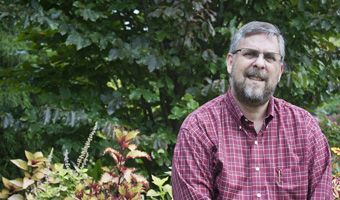Dr. Brian McCarthy, College of Arts & Science Associate Dean for Faculty, Graduate Studies and Research and Professor of Forest Ecology, spoke on Amur honeysuckle, one of the top invading species in the United States, at the Invasive Ornamental Plant Symposium & Working Group” in Chicago last week.
He discussed its threats to native forest ecosystems at a symposium talk in morning. Afternoon discussions were dedicated to working groups with the goal of engaging the green industry and helping its members figure out how to stop selling and marketing invasive plants species throughout the Midwest.
The native habitat for Amur Honeysuckle (Lonicera maackii) is in Asia—north and west China, Mongolia, Japan, Korea and southeast Russia. Its first recorded arrival in the United States was an ornamental planting in 1898. Grown as an ornamental plant for its attractive flowers and fruits, and also a hedge, it escaped cultivation and naturalized in the central and northeastern United States.
“Lonicera is well-adapted to moving around in a heterogeneous landscape by animal species (such as birds and deer) that are already prominent components of the biological community,” McCarthy said. “But, are there any negative effects of the species? Or, is this just simply an example of a species that has migrated into a new region and become integrated into our eastern U.S. ecosystems?” he asks.
“Numerous removal and control projects have shown there is little to nothing green below Lonicera canopies once removed. This is simply not the case with native shrub species.” To date, there is good empirical evidence to show that Lonicera maackii negatively impacts forest seed banks, forest herb communities, tree seedling regeneration, sapling and shrub diversity, overstory productivity, stream macroinvertebrates, leaf litter decomposition rates, microbial communities, amphibians and birds.
His conclusions:
- Amur honeysuckle represents a tremendous threat to Midwestern hardwood forest communities.
- Site invasion quickly results in a loss of understory diversity in less than 10 years and an irrevocable change after 20 years.
- Honeysuckle has a marked impact on overstory growth and productivity and will significantly impact timber economics.
- Honeysuckle impacts virtually every aspect of native forest ecosystems from vegetation to animals to soils to streams.
- The species can be controlled, but ease of eradication and associated costs are less if caught early on. Restoration efforts may be difficult after long periods since invasion.



















Comments